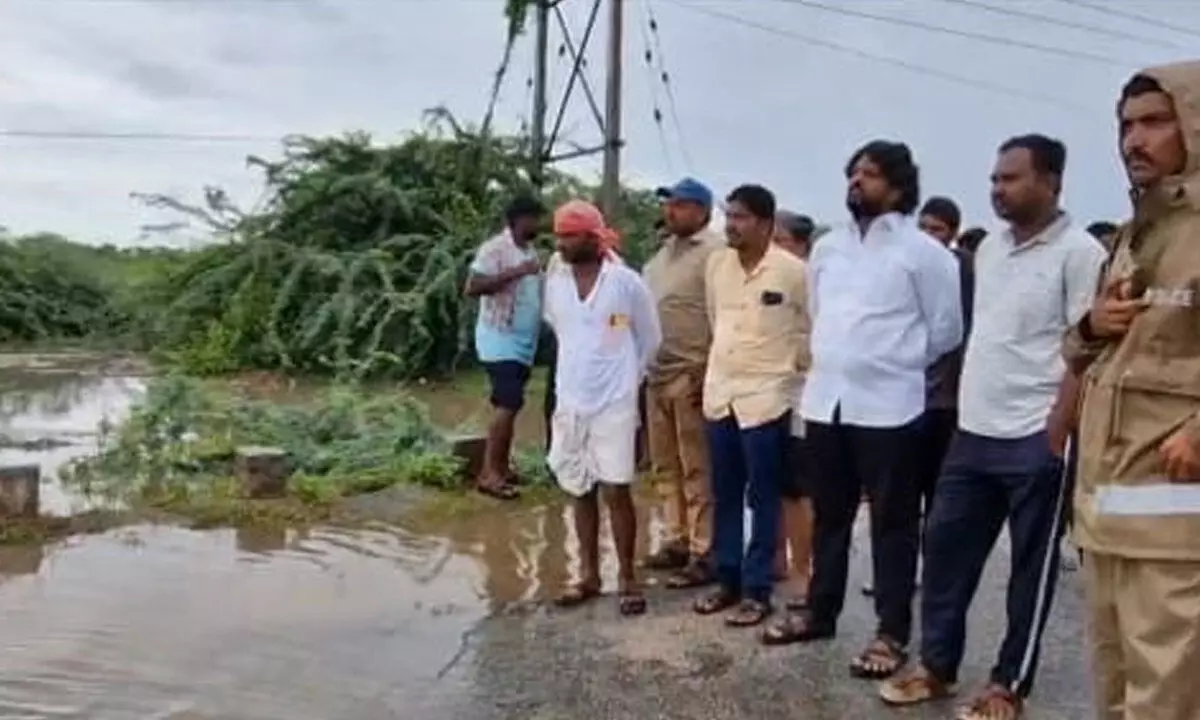Live
- Jana Sena MLA Pulaparthi Ramanjaneyulu Elected as PAC chairman
- Stage set for counting of votes for Jharkhand Assembly elections
- MLA Sri Ganesh Engages ASHA Workers and Resource Persons in Caste Census Meeting
- Supreme Court verdict on validity of Preamble modification in 1976 likely on November 25
- ‘Zebra’ movie review: A gripping tale of banking fraud and redemption
- Saurabh Netravalkar, Unmukt Chand, Dwayne Smith and Rahkeem Cornwall headline USPL
- NPP asks members not to attend meeting called by Biren govt
- Bulls roar on Dalal Street, Sensex and Nifty up over 2 pc
- Over 880,000 people displaced in Lebanon, food security deteriorates: UN
- BGT 2024-25: Bumrah picks 4-17 as Australia trail India by 83 runs in 17-wicket day
Just In

The heavy rains that occurred in the early hours of Tuesday in the Alampur constituency of Jogulamba Gadwal district have brought to light several critical issues related to infrastructure, disaster preparedness, and the socio-economic impact on the local population.
Gadwal: The heavy rains that occurred in the early hours of Tuesday in the Alampur constituency of Jogulamba Gadwal district have brought to light several critical issues related to infrastructure, disaster preparedness, and the socio-economic impact on the local population. The event underscores the vulnerability of the region to extreme weather conditions and the cascading effects on daily life, transportation, and agriculture.
Infrastructure Vulnerability:
The flooding of the main road connecting Raichur in Karnataka to Alampur due to the overflow of the Pedda Vagu stream highlights the inadequate infrastructure resilience in the region. The fact that a major transportation route was rendered unusable for several hours points to the need for improved drainage systems and the construction of flood-resistant infrastructure. This road serves as a crucial link for both people and goods between the states, and its disruption not only isolates communities but also hampers economic activities.
Disruption of Daily Life:
The flooding led to the isolation of several villages, including Tupatrala, Medikonda, Pulikal, Chinna Tandrapadu, Venisompuram, and Keshavaram. Residents in these areas found themselves stranded, unable to access essential services or travel to work. This kind of disruption can have lasting effects, especially for daily wage laborers and small businesses that rely on consistent access to markets and customers.
The temporary isolation of these villages also raises concerns about the availability of emergency services. In situations where medical emergencies or other critical needs arise, the lack of accessible roads can turn a manageable situation into a life-threatening one. The local authorities' warnings to avoid travel were a necessary precaution, but they also highlight the lack of alternative routes or transportation options in times of crisis.
Agricultural Impact:
Perhaps one of the most significant impacts of the heavy rains is on agriculture, which is the primary livelihood for many residents in the Alampur constituency. The flooding of fields, particularly during the crop-growing season, can have devastating effects. Farmers have reported that their crops, which were in the growth phase, have been submerged by the sudden influx of water. This has led to an estimated loss of up to ₹40,000 per acre, a significant financial hit for small and marginal farmers.
The timing of the rains, when crops are particularly vulnerable, exacerbates the situation. Continuous heavy rains can lead to waterlogging, which damages the roots of crops and reduces yield. For many farmers, this could mean not just a loss of income but also a potential shortage of food supplies in the coming months.
Education and Public Safety:
In the aftermath of the rains, there have been calls from parents in the affected villages for the closure of schools in areas where streams and rivulets have overflowed. This concern is valid, given the risks associated with children traveling through flooded areas. The disruption of education, even temporarily, can have a cumulative effect, especially in rural areas where access to quality education is already limited.
Public safety remains a critical issue. The lack of real-time information about which areas are most affected by flooding means that residents are often left to navigate dangerous conditions with little guidance. This underscores the need for improved communication strategies, including the use of social media and local media outlets, to keep the public informed during such events.
Need for Proactive Measures:
The recurring nature of such weather events calls for more proactive measures from both local and state governments. While immediate responses like warnings and advisories are crucial, long-term solutions are needed to mitigate the impact of heavy rains on the region. These could include the construction of better drainage systems, flood barriers, and the elevation of key roads and bridges.
Additionally, there should be a focus on disaster preparedness training for local communities, ensuring that residents know how to respond in the event of sudden flooding. Investment in early warning systems that can predict and communicate the risks of flooding before they occur would also be beneficial.
The heavy rains in the Alampur constituency are a reminder of the ongoing challenges faced by rural areas in dealing with extreme weather. The disruption of transportation, the isolation of communities, the damage to crops, and the impact on education all highlight the need for a comprehensive approach to disaster management and infrastructure development. By addressing these issues, the region can become more resilient to future weather events, ensuring that the livelihoods and safety of its residents are better protected.

© 2024 Hyderabad Media House Limited/The Hans India. All rights reserved. Powered by hocalwire.com







